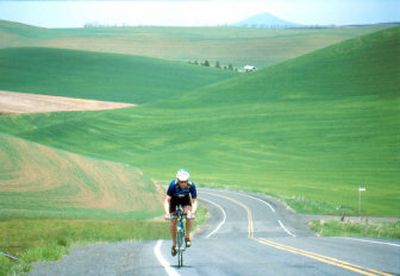Contour of the Palouse

This has to be some of the most beautiful farmland in the country. Known as the Palouse, it’s 5 million acres of green or gold hills, depending on the time of year and what’s planted, that can be found in Washington’s Whitman County and Idaho’s Latah County.
At first the irregular, rolling hills are unsettling. They may remind you of huge ocean waves that are about to capsize the car. But once you adjust to the undulating hills, it’s hard not to enjoy the colors and forms. Somehow the farmers can plow, plant, cultivate and harvest on these hills. Many of the hillsides are quite steep, and it’s hard to see how a tractor could work on them without rolling over.
In Cort Conley’s book, “Idaho for the Curious,” he explains that prior to tractor power, multiple hitched horses were used on the steep hills. It was common to see teams of 16 to 44 horses pulling a combine during the harvest. At the time visitors from other parts of the country were amazed at the use of extended teams of horses.
Crops are rotated, and contour farming is used. The visual effect is striking with uneven hills banded with various crops growing around and over each hill extending to the horizon.
The climate and the soil are perfect for growing wheat. That fact was discovered back in the 1870s. Now it is known that the land is composed of loose, spongy volcanic soil that can reach a depth of 36 feet. How good is the soil? According to Whitman County statistics, the average U.S. wheat farmer harvests 35 bushels of wheat per acre each year. In Whitman County the average harvest is an incredible 85 bushels per acre.
Fields are planted on a rotating basis with barley, peas and lentils, which gives us visitors a great mix of colors and textures on the hills to look at.
As if the view isn’t enough, the barns are enormous, old and beautiful. They used to be food storehouses for the family livestock. Certainly the entire weekend could be spent taking photos of the various barns. Each has its own color (they are not all red), shape (there are at least two round ones) and level of decay (sad to see them fall apart.)
No one seems to talk about the old farm homes. You know, the twostory framed house with the open air, wraparound front porch. The front roof is supported by white columns with a porch swing hanging from the ceiling. Classic, wonderful old homes with a picket fence that you would expect to see in the movies. They can be found on the Palouse.
Take some back roads through the Palouse. Linger among the hills and the small towns like Palouse, Oaksdale, Garfield, and Tekoa. Don’t be too surprised if the locals driving past greet you with a wave of their hand. Discover rural farm scenes you will never see speeding through at 60 mph on the main highways. But be careful and don’t get seasick.